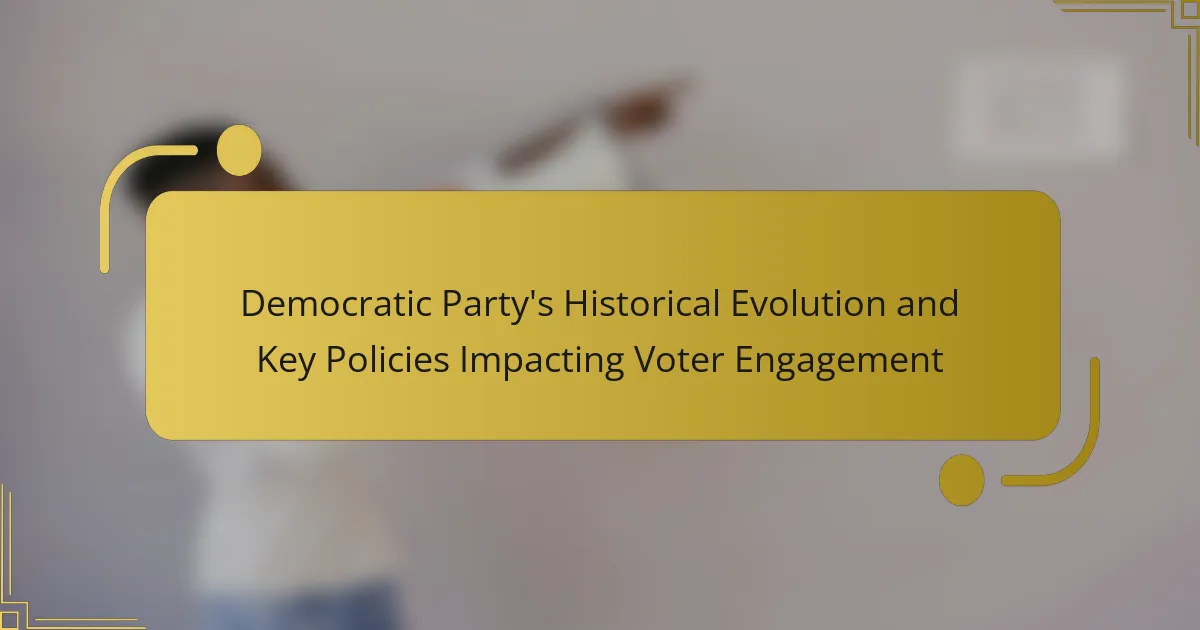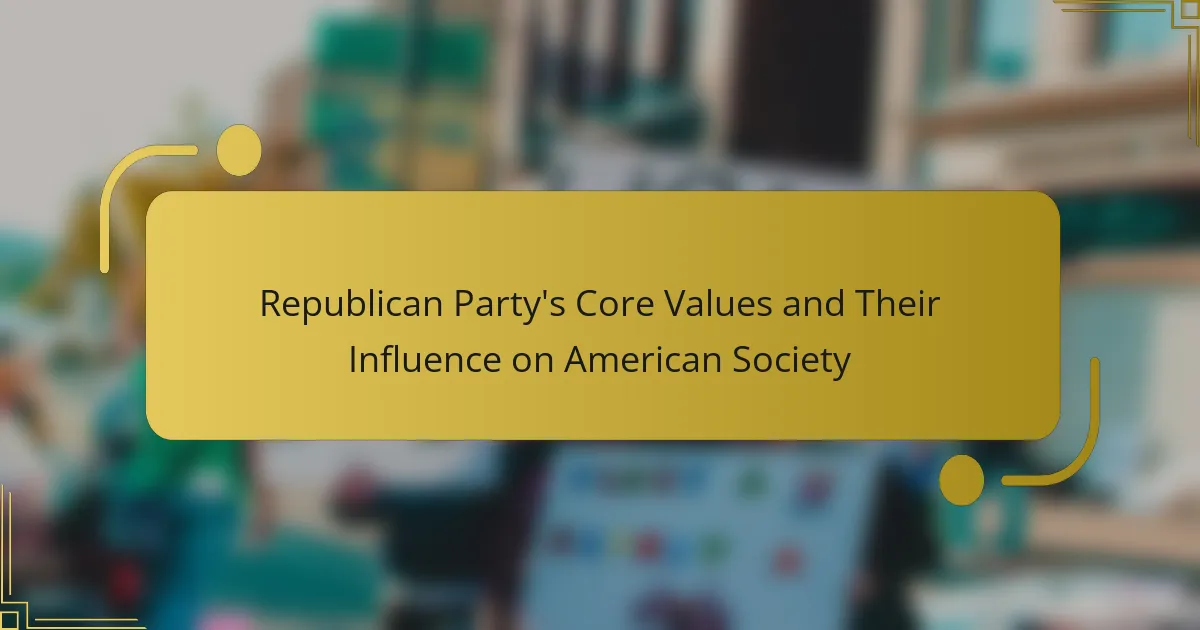The Democratic Party, originally established as the Democratic-Republican Party by Thomas Jefferson in 1792, has undergone significant transformations throughout its history. This article examines the party’s evolution from its early agrarian roots to its modern focus on social equity and government intervention in the economy. Key historical milestones include the shift towards populism under Andrew Jackson, the embrace of progressive reforms in the early 20th century, and the pivotal changes during the Civil Rights Movement. Additionally, the article highlights important policies that have enhanced voter engagement, such as the Voting Rights Act of 1965 and the National Voter Registration Act of 1993, as well as contemporary strategies aimed at increasing participation among young and marginalized voters.
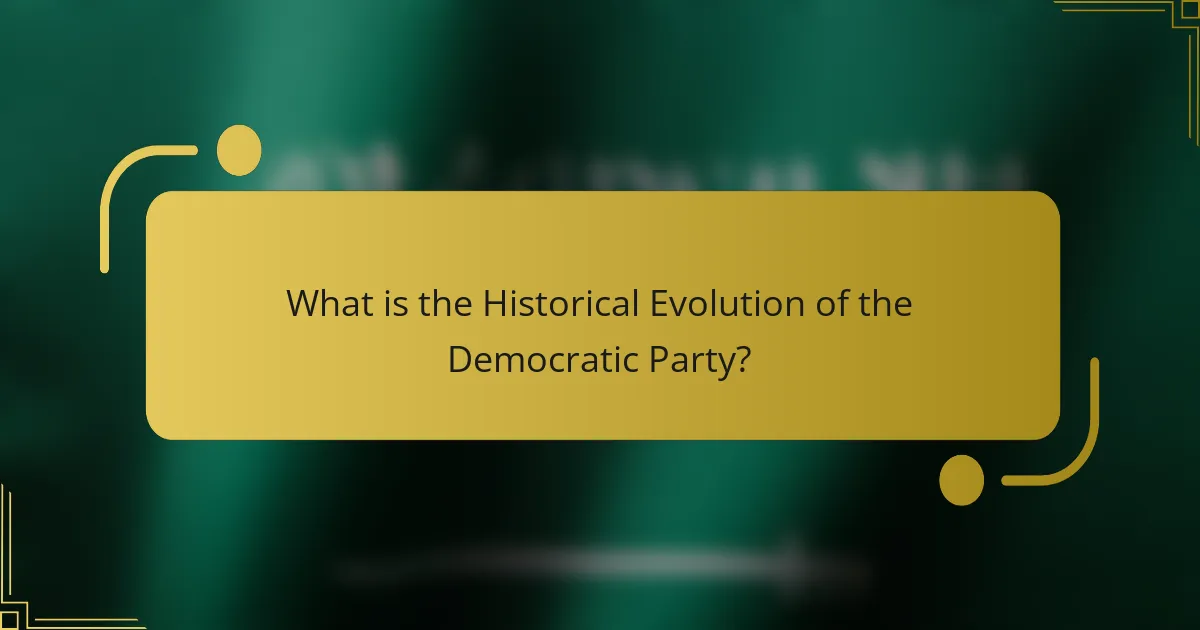
What is the Historical Evolution of the Democratic Party?
The Democratic Party has evolved significantly since its founding in the early 19th century. Originally formed as the Democratic-Republican Party by Thomas Jefferson in 1792, it aimed to represent agrarian interests. The party fragmented in the 1820s, leading to the emergence of the modern Democratic Party under Andrew Jackson. Jackson’s presidency marked a shift towards populism and the expansion of suffrage for white males.
Throughout the 19th century, the Democratic Party often supported slavery and states’ rights. This stance contributed to its split during the Civil War, resulting in the formation of the Confederate States. After the war, the party struggled to regain influence in the Reconstruction era due to its association with the Confederacy.
In the early 20th century, the party began to embrace progressive reforms under leaders like Woodrow Wilson. This included support for labor rights and anti-trust legislation. The New Deal era in the 1930s marked a significant transformation, as Franklin D. Roosevelt’s policies aimed to address the Great Depression and expanded the role of government in economic recovery.
The Civil Rights Movement in the 1960s further reshaped the party. Democratic leaders, such as Lyndon B. Johnson, championed civil rights legislation, attracting African American voters. This shift led to a realignment, with many Southern whites moving to the Republican Party.
In recent decades, the Democratic Party has focused on issues like healthcare, climate change, and social justice. The election of Barack Obama in 2008 represented a historic moment, symbolizing a broader acceptance of diversity within the party. The Democratic Party continues to adapt its platform to address contemporary issues while maintaining its historical roots in advocating for social equity and government intervention in the economy.
How did the Democratic Party originate and evolve over time?
The Democratic Party originated in the early 19th century as the Democratic-Republican Party. It was founded by Thomas Jefferson and James Madison in opposition to the Federalist Party. The party aimed to promote agrarian interests and states’ rights.
Over time, the Democratic-Republican Party split into factions. The faction that became known as the Democratic Party emerged in the 1820s. Andrew Jackson became its first significant leader, advocating for the “common man” and expanding suffrage to all white men.
The party’s platform evolved throughout the 19th century. It supported westward expansion and initially upheld slavery. However, the Civil War and Reconstruction forced a reevaluation of its policies.
By the late 19th century, the party began to advocate for labor rights and economic reforms. The New Deal in the 1930s marked a significant shift toward social welfare policies under Franklin D. Roosevelt.
In the mid-20th century, the Democratic Party embraced civil rights, which led to a realignment of its voter base. This evolution continued into the 21st century, focusing on issues like healthcare, climate change, and social justice.
Today, the Democratic Party is characterized by its commitment to progressive policies and inclusivity. Its historical evolution reflects broader social and political changes in the United States.
What key events shaped the early years of the Democratic Party?
The key events that shaped the early years of the Democratic Party include the founding of the party in the 1820s and the election of Andrew Jackson in 1828. The party emerged from the Democratic-Republican Party, which was founded by Thomas Jefferson. The split between factions led to the establishment of the Democratic Party as a distinct entity. Jackson’s presidency marked the rise of populism and the expansion of suffrage to more white males. The party’s platform focused on agrarian interests and opposition to the national bank. The Nullification Crisis of 1832 tested federal authority and highlighted states’ rights issues within the party. Additionally, the Indian Removal Act of 1830, supported by Jackson, had lasting implications for Native American relations. These events collectively defined the party’s early identity and policies.
How did the Democratic Party’s platform change throughout the 19th century?
The Democratic Party’s platform evolved significantly throughout the 19th century. Initially, the party supported agrarian interests and states’ rights. This focus aligned with the party’s roots in the early 1800s under Thomas Jefferson. As the century progressed, the party began to embrace issues like westward expansion and the protection of slavery. The Democratic Party’s platform became more aligned with Southern interests, particularly after the Missouri Compromise of 1820.
By the 1840s, the party adopted the concept of Manifest Destiny, advocating for territorial expansion. This shift reflected a growing belief in American exceptionalism. The party’s stance on slavery intensified in the 1850s, leading to internal divisions. The Kansas-Nebraska Act of 1854 exemplified this conflict, as it allowed for popular sovereignty on the issue of slavery in new territories.
Following the Civil War, the Democratic Party struggled to redefine its platform. The Reconstruction era saw the party opposing federal intervention in Southern states. By the late 19th century, the party began to focus on issues like labor rights and economic reform. The rise of industrialization prompted a shift toward addressing the concerns of urban workers. Overall, the Democratic Party’s platform transformed from agrarian and pro-slavery to one that increasingly addressed labor and economic issues as the century closed.
What major milestones marked the Democratic Party’s development?
The Democratic Party’s development is marked by several major milestones. The party was founded in the early 19th century, specifically in 1828. It emerged from the Democratic-Republican Party, aiming to represent agrarian interests. The election of Andrew Jackson in 1828 solidified its populist appeal. In the 1860s, the party faced a significant split over slavery, leading to the formation of the Republican Party. The New Deal era in the 1930s marked a pivotal shift, as Franklin D. Roosevelt introduced policies to combat the Great Depression. The Civil Rights Movement in the 1960s further transformed the party, as it embraced racial equality. The nomination of Barack Obama in 2008 represented a historic moment as he became the first African American president. Each of these milestones reflects the party’s evolving platform and response to societal changes.
Which significant legislation did the Democratic Party influence in the 20th century?
The Democratic Party significantly influenced the Civil Rights Act of 1964. This landmark legislation aimed to end discrimination based on race, color, religion, [censured], or national origin. It was a pivotal moment in the American civil rights movement. The act prohibited unequal application of voter registration requirements. It also outlawed segregation in schools and public places. President Lyndon B. Johnson, a Democrat, played a crucial role in its passage. His administration worked closely with civil rights leaders to ensure its success. The act marked a significant shift in federal policy towards civil rights, showcasing the Democratic Party’s commitment to social justice.
How did the Civil Rights Movement impact the Democratic Party’s identity?
The Civil Rights Movement significantly reshaped the Democratic Party’s identity. It led the party to embrace civil rights as a core principle. This shift attracted African American voters and other minority groups. The Democratic Party’s support for the Civil Rights Act of 1964 was pivotal. This legislation outlawed discrimination based on race, color, religion, [censured], or national origin. The Voting Rights Act of 1965 further solidified this commitment. It aimed to eliminate barriers to voting for African Americans. These actions transformed the party into a champion of social justice and equality. Consequently, the Democratic Party’s identity became closely linked with progressive values.
What role has the Democratic Party played in American politics?
The Democratic Party has played a significant role in American politics as one of the two major political parties. It has been a key player in shaping policy and public opinion since its founding in the early 19th century. The party has historically advocated for social justice, civil rights, and economic equality. Major events include the New Deal in the 1930s, which aimed to address the Great Depression. The Civil Rights Movement in the 1960s saw the party support legislation for racial equality. In recent decades, the Democratic Party has focused on healthcare reform, climate change, and social issues. The party’s platform has evolved to reflect changing societal values and demographics. Notably, it has aimed to engage younger voters and diverse communities. This engagement has influenced election outcomes and legislative priorities.
How has the Democratic Party’s voter base changed over the decades?
The Democratic Party’s voter base has shifted significantly over the decades. In the early 20th century, the party primarily attracted white, rural voters in the South. The New Deal era in the 1930s expanded the base to include urban working-class individuals and minorities. By the 1960s, civil rights legislation drew African American voters into the party, particularly in the North.
In the late 20th century, the Democratic Party increasingly appealed to women and younger voters. The party’s stance on social issues, like abortion and [censured] rights, further diversified its voter base. Recent decades have seen a growing emphasis on issues like climate change and healthcare, attracting younger and more progressive voters.
As of the 2020 election, the Democratic Party’s base is characterized by a more diverse demographic, including significant support from Hispanic and Asian American communities. This evolution reflects broader societal changes and shifts in voter priorities over time.
What strategies has the Democratic Party employed to engage voters?
The Democratic Party has employed various strategies to engage voters. These strategies include grassroots organizing, targeted outreach, and digital engagement. Grassroots organizing involves mobilizing local volunteers to connect with communities. Targeted outreach focuses on specific demographics, such as young voters and minorities. Digital engagement utilizes social media platforms to reach a broader audience. The party also emphasizes issues like healthcare and climate change to resonate with voter concerns. In recent elections, they have utilized data analytics to tailor their messages effectively. These strategies aim to increase voter turnout and participation in the electoral process.
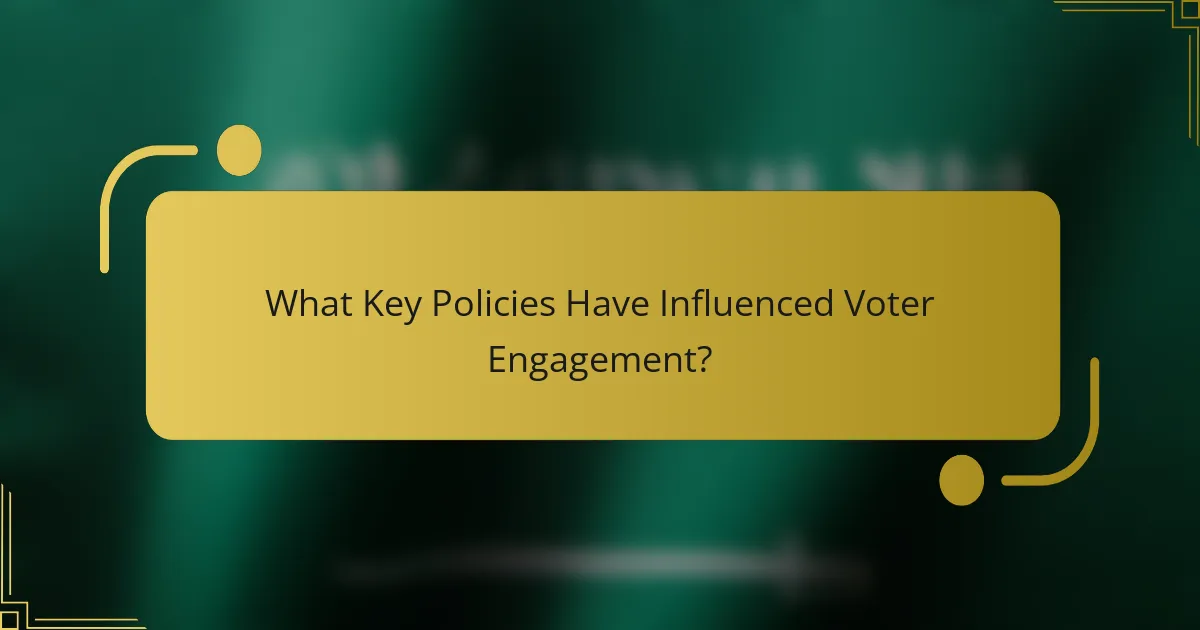
What Key Policies Have Influenced Voter Engagement?
Key policies that have influenced voter engagement include the Voting Rights Act of 1965 and the National Voter Registration Act of 1993. The Voting Rights Act aimed to eliminate barriers to voting for African Americans. It prohibited discriminatory practices that disenfranchised voters. This act significantly increased voter registration and participation among minority groups. The National Voter Registration Act streamlined the voter registration process. It allowed individuals to register at the same time as applying for a driver’s license. This policy led to millions of new registered voters. Other policies include same-day registration laws and efforts to expand access to early voting. These measures have collectively aimed to enhance voter turnout and engagement in the electoral process.
How have Democratic policies historically impacted voter turnout?
Democratic policies have historically increased voter turnout. Initiatives such as the Voting Rights Act of 1965 aimed to eliminate racial discrimination in voting. This legislation significantly boosted participation among African American voters. Additionally, the Democratic Party’s support for social welfare programs has often mobilized lower-income voters. Policies like the New Deal in the 1930s expanded the electorate by addressing economic concerns. Furthermore, recent efforts to expand access to voting, such as automatic voter registration, have also contributed to higher turnout rates. Studies indicate that these policies have led to increased engagement in elections, particularly among marginalized communities.
What specific policies were implemented to increase voter registration?
The National Voter Registration Act of 1993 established policies to increase voter registration. This law mandated states to offer voter registration opportunities at the same time as applying for a driver’s license or social services. Additionally, the Act required states to maintain voter registration lists and ensure accessibility for all citizens. The Help America Vote Act of 2002 further enhanced registration processes by providing funds for states to improve their systems. These policies collectively aimed to simplify registration and increase participation in elections.
How have voter protection laws evolved under Democratic leadership?
Voter protection laws have expanded significantly under Democratic leadership. The Democratic Party has prioritized legislation aimed at increasing voter access and reducing barriers. Key laws include the Voting Rights Act of 1965, which aimed to eliminate racial discrimination in voting. More recent measures, such as the For the People Act and the John Lewis Voting Rights Advancement Act, seek to restore voting rights protections. These laws emphasize automatic voter registration, early voting, and mail-in voting options. Democratic leadership has also focused on combating voter ID laws perceived as discriminatory. The evolution reflects a commitment to ensuring equitable access to the ballot.
What recent initiatives has the Democratic Party introduced to boost voter engagement?
The Democratic Party has introduced several recent initiatives to boost voter engagement. These include efforts to simplify voter registration processes. They have implemented automatic voter registration in multiple states. The party is also promoting early voting and mail-in voting options. Additionally, they are focusing on outreach programs targeting underrepresented communities. These initiatives aim to increase participation among young voters and minorities. Recent surveys indicate a rise in voter turnout linked to these efforts. The Democratic National Committee has allocated funds to support these initiatives nationwide.
How effective have these initiatives been in recent elections?
Recent initiatives by the Democratic Party have shown significant effectiveness in elections. For example, voter turnout in the 2020 election reached 66.8%, the highest for a presidential election since 1900. Initiatives focused on expanding access, such as mail-in voting and early voting, contributed to this increase. States that implemented automatic voter registration saw turnout increases of up to 10%. Furthermore, targeted outreach efforts to young voters resulted in a 50% increase in participation compared to previous elections. Data from the U.S. Census Bureau indicates that these strategies have successfully engaged diverse demographics. Overall, these initiatives have played a crucial role in mobilizing voters and shaping electoral outcomes.
What challenges does the Democratic Party face in engaging voters today?
The Democratic Party faces significant challenges in engaging voters today. One major challenge is voter apathy, which has increased in recent elections. According to a Pew Research Center study, only 50% of eligible voters participated in the 2022 midterms. Additionally, there is a growing polarization in American politics. Many voters feel disconnected from traditional party platforms. This disconnect can lead to lower engagement rates among younger voters. Furthermore, misinformation and disinformation campaigns have made it harder for the party to communicate effectively. Lastly, the party struggles with internal divisions that can dilute its message and impact voter mobilization efforts.
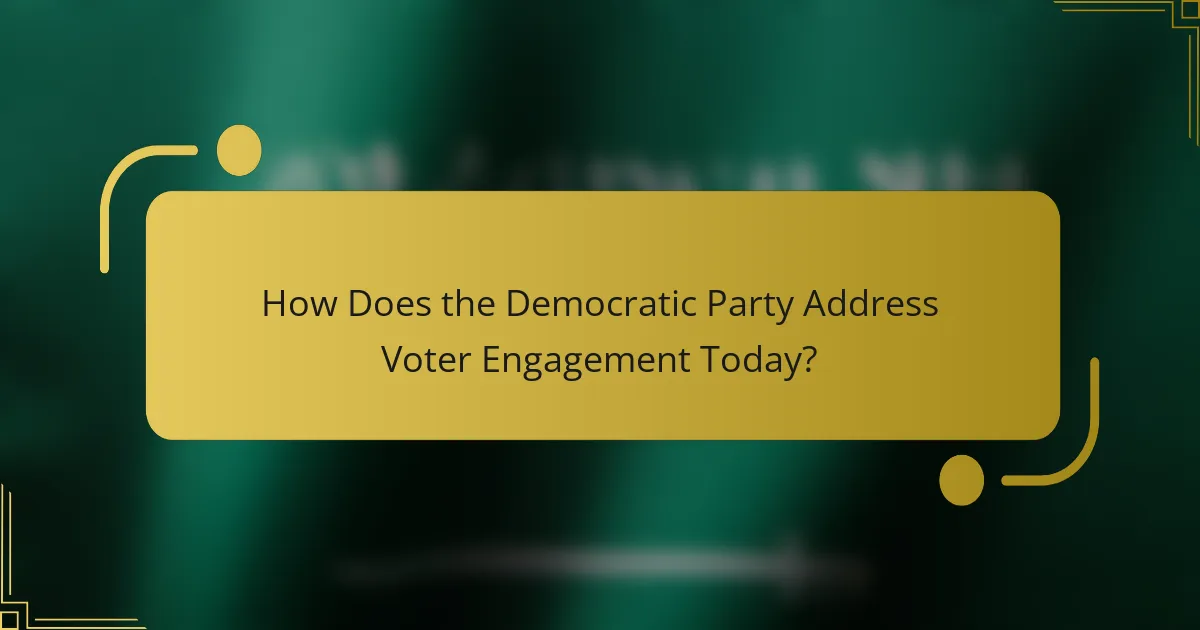
How Does the Democratic Party Address Voter Engagement Today?
The Democratic Party addresses voter engagement today through various strategies aimed at increasing participation. These strategies include grassroots organizing, digital outreach, and community engagement initiatives. The party focuses on mobilizing young voters and marginalized communities. They employ social media campaigns to reach a broader audience. The Democratic National Committee has launched programs like “Vote 2022” to encourage turnout. According to the U.S. Census Bureau, voter turnout among young voters increased by 50% in the 2020 election. This indicates the effectiveness of their engagement efforts. Additionally, the party advocates for policies like automatic voter registration and expanded voting access. These measures aim to remove barriers to participation.
What current strategies are being used to connect with voters?
Current strategies to connect with voters include digital outreach, grassroots organizing, and community engagement. Digital outreach utilizes social media platforms to disseminate information and mobilize supporters. Grassroots organizing focuses on building local networks to foster personal connections. Community engagement involves hosting events and forums to discuss issues directly with constituents. These methods aim to enhance voter turnout and participation. Data indicates that campaigns employing these strategies see increased voter engagement, particularly among younger demographics.
How is technology influencing the Democratic Party’s voter engagement efforts?
Technology is significantly influencing the Democratic Party’s voter engagement efforts. Digital platforms enable targeted outreach to specific demographics. Tools like social media allow for real-time communication and mobilization. Data analytics help identify voter preferences and behaviors. The use of mobile apps facilitates voter registration and information dissemination. Virtual events have expanded outreach beyond traditional venues. Online fundraising has increased financial support for campaigns. Research by the Pew Research Center indicates that 81% of Americans use social media, enhancing the party’s ability to engage with voters.
What role do grassroots movements play in the Democratic Party’s strategy?
Grassroots movements play a crucial role in the Democratic Party’s strategy. They mobilize local communities and engage voters on key issues. These movements often drive policy discussions and influence party platforms. They help to identify and elevate diverse voices within the party. Grassroots organizing has been essential in recent electoral successes. For example, movements like Indivisible have mobilized millions to advocate for progressive policies. This engagement fosters a sense of ownership among constituents. It also strengthens the party’s connection to its base, enhancing voter turnout. Overall, grassroots movements are vital for energizing the Democratic Party’s grassroots support and shaping its agenda.
What best practices can enhance voter engagement for the Democratic Party?
Utilizing grassroots organizing is a best practice that can enhance voter engagement for the Democratic Party. Grassroots efforts mobilize local communities and encourage participation in the electoral process. Engaging volunteers to connect with voters fosters a sense of ownership and community involvement. Data-driven outreach strategies, such as targeted messaging based on demographic analysis, can effectively reach specific voter groups. Additionally, leveraging social media platforms amplifies communication and mobilizes supporters. Research shows that personalized voter contact increases turnout rates significantly. For instance, a study by the National Bureau of Economic Research found that door-to-door canvassing can raise participation by 7-10%. Implementing these strategies can lead to higher voter engagement and increased electoral success for the Democratic Party.
How can the Democratic Party better utilize social media for outreach?
The Democratic Party can better utilize social media for outreach by creating targeted campaigns that resonate with specific demographics. Engaging content tailored to the interests of younger voters can increase participation. Utilizing data analytics helps identify which platforms are most effective for different age groups. Regularly updating followers about policies and events fosters a sense of community. Collaborating with influencers can expand the party’s reach to diverse audiences. Hosting live Q&A sessions allows direct interaction with constituents. These strategies have proven effective in past elections, as seen in the 2020 campaign, where social media played a crucial role in voter mobilization.
What are effective methods for mobilizing young voters?
Effective methods for mobilizing young voters include leveraging social media campaigns, organizing community events, and providing accessible information about voting processes. Social media platforms have proven to be effective tools for reaching younger demographics. Research indicates that 70% of young voters engage with political content on social media. Community events foster a sense of belonging and encourage participation. Additionally, simplifying information about registration and voting can increase turnout. Studies show that clear messaging about voting deadlines and procedures enhances young voter engagement.
The Democratic Party is the primary entity explored in this article, which details its historical evolution and key policies influencing voter engagement. Founded in the early 19th century as the Democratic-Republican Party, the article traces the party’s transformation through significant milestones, including its alignment with civil rights and progressive reforms. The discussion highlights pivotal legislation, such as the Voting Rights Act and the National Voter Registration Act, which have shaped voter participation. Additionally, the article examines contemporary challenges and strategies the Democratic Party employs to engage voters, particularly young and marginalized communities, through grassroots organizing and digital outreach efforts.
